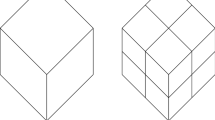Abstract
Unified way for dealing with the problems of three dimensional solid, each type of plates and shells etc. was presented with the virtual boundary element least squares method(VBEM). It proceeded from the differential equations of three-dimensional theory of elasticity and employs the Kelvin solution and the least squares method. It is advantageous to the establishment of the models of a software for general application to calculate each type of three-dimensional problems of elasticity. Owing to directly employing the Kelvin solution and not citing any hypothesis, the numerical results of the method should be better than any others. The merits of the method are highlighted in comparison with the direct formulation of boundary element method (BEM). It is shown that coefficient matrix is symmetric and the treatment of singular integration is rendered unnecessary in the presented method. The examples prove the efficiency and calculating precision of the method.
Similar content being viewed by others
References
XU Qiang, SUN Huan-chun. Virtual boundary element least square method for three-dimensional problems of thick shell[J]. Journal of Dalian University of Technology,1996,36(4): 413–418. (in Chinese)
XU Qing, SUN Huan-chun. Virtual boundary element least square collocation method[J]. Chinese Journal of Computational Mechanics, 1997,14(2): 166–173. (in Chinese)
SUN Huan-chun, XU Qiang. Virtual boundary element method for solving mathematical equations and relationship between it and relative methods[J]. Journal of Dalian University of Technology, 1999,39(2): 183–190. (in Chinese)
XU Qiang, SUN Huan-chun. Three-dimensional virtual boundary element analysis of plate bending [J]. Engineering Mechanics, 2000, 17 3: 23–30. (in Chinese)
XU Qiang, DAI Yue-hui. Solving the composite structures of different mediums with virtual boundary element method[J]. Journal of the China Railway Society, 2000, (supple): 76–78. (in Chinese)
FU Bao-lian, TAN Wen-feng. Reciprocal theorem method for solving the problems of bending of thick rectangular plates [J]. Applied Mathematics and Mechanics (English Edition), 1995,16(4): 391–403.
Wang Y C, Ye J Q, Wang Z H. Spline boundary element method for shallow thin-shells[A]. In: DU Qing-hua Ed. Boundary Elements[C]. Beijing: Pergamon Press,1986: 375–382.
Burges G J, Mahajerin E. A comparison of the boundary element and superposition methods[J]. Comput Structures,1984,19(2): 697–705.
Brebbia C A, Telles J C F, Wrobel L C. Boundary Element Techniques Theory and Application in Engineering[M]. Berlin: Springer-Verlag,1984: 177–236.
Author information
Authors and Affiliations
Rights and permissions
About this article
Cite this article
Xu, Q., Sun, Hc. Unified Way for Dealing with Three-Dimensional Problems of Solid Elasticity. Applied Mathematics and Mechanics 22, 1357–1367 (2001). https://doi.org/10.1023/A:1022845603028
Issue Date:
DOI: https://doi.org/10.1023/A:1022845603028




